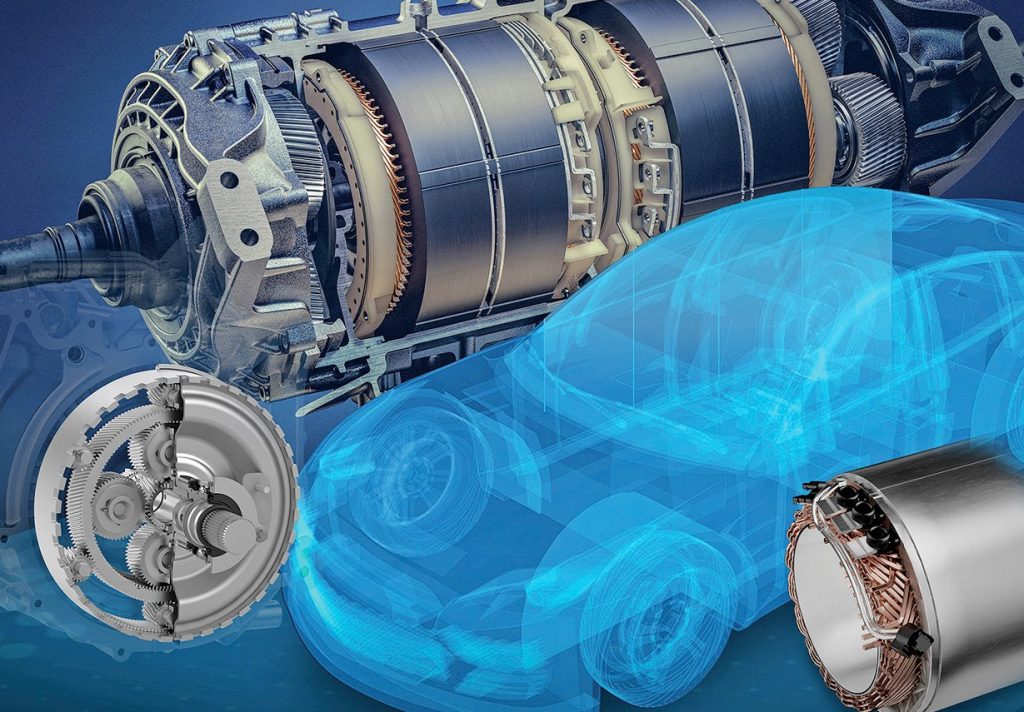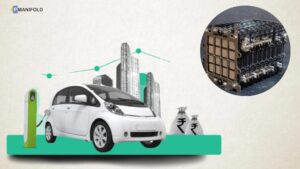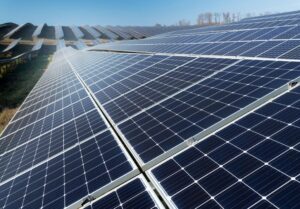
Electric vehicles (EVs) have emerged as a transformative force in the automotive industry, promising a cleaner, more sustainable future for transportation. At the heart of every electric vehicle lies a crucial component: the electric motor. This compact yet powerful device is responsible for converting electrical energy into mechanical motion, propelling EVs forward with remarkable efficiency. In this blog, we shall delve into theworld of motors for electric vehicles, exploring their types, characteristics, significance and players in the EV revolution.
Types of Electric Motors:
Electric motors for EVs are classified into two main categories: DC and AC. While both find place in EV application, DC motors stand out for their robustness and simple control. DC Motors come in brushed and brushless variants. Brushed DC motors, though cost-effective and offering high torque at low speeds, are less favoured in EVs due to their larger size, lower efficiency, and frequent maintenance needs. In contrast, brushless DC motors excel with notably higher efficiency, employing electronic commutation rather than brushes. AC motors, on the other hand, boast benefits like superior efficiency, reduced maintenance, heightened reliability, and regenerative capabilities for efficient braking energy recovery—making them a popular choice in EVs.

The performance of the EV is intricately tied to the specific electrical motor specifications, which are defined by the torque-speed and power-speed characteristics of the traction motor. Below are the key features of the Electric Motor required for an EV

EV Motors and their characteristics:
DC Motors: Simplifying Control and Boosting Torque
- Robust Build and Simple Control: DC motors shine in EVs with their sturdy construction and straightforward control.
- Torque-Speed Advantage: They deliver high torque at low speeds due to appropriate torque-speed characteristics.
- Drawbacks: However, they come with size constraints, lower efficiency, maintenance demands, and limited speed range due to brush friction.
Permanent Magnet Brushless DC Motors (PM BLDC)
- Magnet Magic: PM BLDC motors use permanent magnets, offering higher efficiency by eliminating rotor losses.
- Constant Power Challenge: They have a shorter constant power operation range, but this can be extended using conduction angle control.
- Limitations: High temperatures affect magnet strength, influencing torque capacity. Mechanical forces and cost are key concerns.
Induction Motors (IM): The Workhorses of EVs
- Simplicity and Reliability: IMs are popular in EVs for their uncomplicated design, high reliability, and robustness.
- Safety Advantage: They can naturally de-energize in case of inverter faults, enhancing EV safety.
- Trade-offs: Slightly lower efficiency compared to PM motors, higher power losses, and lower power factor are their downsides.
Permanent Magnet Synchronous Motors (PMSM): Efficiency and Power Density
- Magnets in Sync: PMSMs, like BLDCs, feature permanent magnets, but with a sinusoidal back EMF waveform.
- Efficiency Prowess: They boast high efficiency and power density, making them ideal traction motors for various electric vehicles.
- Concerns: High costs, eddy current loss at high speed, and reliability risks due to potential magnet breakage are considerations.
Switched Reluctance Motors (SRM): Torque Titans
- High Torque Advantage: SRMs excel in applications requiring high torque, including EVs
- Robust and Efficient: They offer fault tolerance, wide constant power operation, and simple maintenance without magnets or brushes.
- Challenges: Increased vibration and noise, along with torque ripple, are drawbacks to consider.Top of Form
- Further research, development, and industry adoption are needed to fully realize their benefits in the EV market
Investments and Collaborations:
Several Indian and international automotive giants have recognized the immense potential of the Indian EV market and are investing and collaborating with start-ups in establishing state-of-the-art motor manufacturing units. These facilities are equipped with cutting-edge technology to produce a wide range of electric motors, catering to diverse vehicle segments, from compact city cars to commercial fleets. For example, Tata AutoComp Systems, India’s leading auto component conglomerate has signed a Joint Venture with Prestolite Electric Beijing, China to Design, Engineer, Manufacture and Supply Powertrain Solutions including Motors for the Indian Electric Vehicle market.
Key Players in EV Motor Manufacturing:
Below are key EV Motor Manufacturers supplying Indian EV OEMs:
| Category | Motor Manufacturer | Country of Origin | Country of Component Manufacturing | Client OEM | Motor Type | Volume(till 02.08.23) |
| e-2W | Ola Electric Technologies | India | India (Tamil Nadu) | Ola Electric | IPM – PMSM | 1,65,747 |
| Nidec Japan | Japan | Germany, China | Hero Electric | BLDC | 1,72,593 | |
| Lucas TVS | India | India (Chennai) | TVS Electric | BLDC | 1,05,089 | |
| Mahle | Germany | 35 locations globally | Ather Energy | PMSM | 1,03,868 | |
| Bosch | Germany | Miskolc, Hungary | Bajaj Chetak | BLDC | 4,231 | |
| e-3W | Bosch | Germany | Miskolc, Hungary | Bajaj | BLDC | 1,669 |
| Jae Sung Tech | South Korea | India (Faridabad & Pune) | Omega Seiki | BLDC | 5,228 | |
| Mahindra Electric MobilityXuzhou Hongrunda Electrical co. ltd | India | India (Bengaluru) | Mahindra | Induction MotorBLDC | 56,109 | |
| China | ||||||
| Long C Motor And Controller Llp | China | India (Delhi) | YC | BLDC | 94,651 | |
| Virya Mobility 5.0 LLP | India | India (Bengaluru) | Piaggio | IPM -PMSM | 20,168 | |
| e-4W | Shanghai AutoEdrive | China | China | Tata cars | PMSM | 42,911 |
| BYD | China | China (Xi’an, Shenzhen, Changsha, Shaoguan) | BYD | PMSM | 1,507 | |
| Huayu Automotive Electric Drive System | China | China | MG | PMSM | 10,920 | |
| e-Buses | Dana TM4 | Canada | Canada, India, US, Italy, England, China,Sweden | Tata buses | PMSM | 675 |
Source: pManifold Analysis &
Thus, while electric vehicles themselves often steal the spotlight, it’s essential to recognize the driving force behind their incredible performance—electric motors. Their ingenious design and efficient operation play a crucial role in making EVs a viable and sustainable mode of transportation. As technology advances, it is expected that even more sophisticated and powerful motors will drive the future of electric mobility, ushering in a new era of cleaner, greener transportation.



